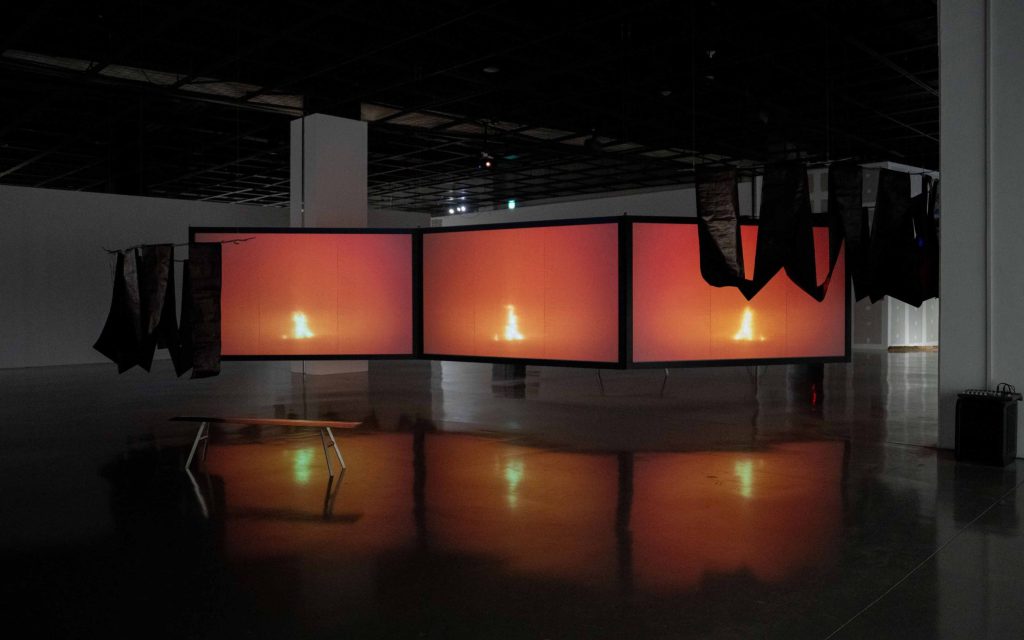
Installation view, Han Mengyun, Night Sutra, Busan Biennale 2024 Night Sutra, 2024, 3 channel 4K digital video, double-sided projection, color and B&W, stereo sound, 46 minutes 13 seconds. The Womb, 2024, Dong bright cloth, cast aluminium branches, artist-designed Dong-inspired stainless steel benches.
Han Mengyun (summer resident 2024) is an interdisciplinary and multimedia artist, poet and mother currently based in London. Her major work, Night Sutra, premiered at the Busan Biennale in 2024. In the summer of that year she was at Delfina Foundation as an artist-in-residence.
Filmed in China, Cambodia, the UK and Switzerland, this 3-channel video and textile installation, commissioned by Busan Biennale 2024, intertwines multilingual tales of genocide, exile, healing, and rebellion. Weaving motifs of femininity with darkness, Night Sutra reflects on transcultural and intergenerational womanhood, motherhood, postpartum depression, and addresses the often-overlooked misogyny within Buddhist traditions.
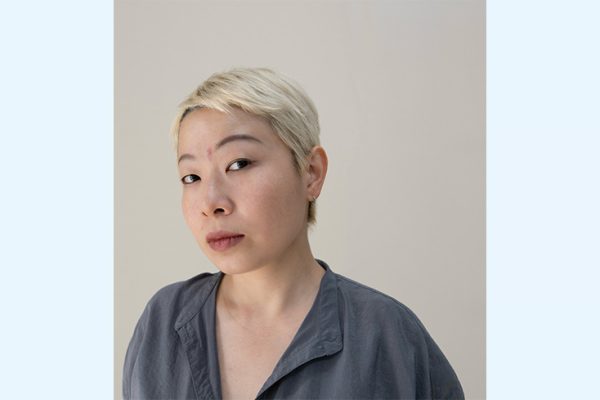
In this extended interview, Han responds to the prompts that May Adadol Ingawanij (writer, curator, professor) provided after visiting the artist in her London studio. Han’s wide-ranging, in-depth responses articulates her artistic formation and her subversive approach to questions of tradition and femininity. The text gives a vivid insight into Han’s extensively researched practice, whose expansiveness combines psychoanalytically informed feminist interventions with embodied explorations of metaphysical, philosophical and religious texts, along with artistic forms, crafts and artefacts, from different periods of history and civilisation across Asia.
Content considerations: please note that this extended interview includes references to sexual violence and slavery in reference to a particularly disturbing case in Xuzhou, China.
May Adadol Ingawanij: Walking into your studio, the first things that struck me were the large old pieces of woodblock placed in rows on a table. They reminded me of the beginning of your three-channel video installation Night Sutra. This installation begins with a series of image-text overlay and juxtaposition. In the middle screen, a bold black and white flowery pattern resembling a woodblock print appears. On the other screens, there are multi-lingual text fragments referring to the tale of the Buddha’s nocturnal enlightenment. I’m interested in the way your practice engages in multiple senses, forms, meanings and ambivalences of the traditional.
Han Mengyun: The idea of multiplicity starts from the work’s title—शर्वरी (śarvarī), which denotes both the night and woman in Sanskrit. This double entendre suggests splitting the yarn into multiple strands of narratives that make up the composite whole of reality. The audience witnesses the sutra about the Buddha’s nocturnal enlightenment in the beginning of the video multiplying into several concurrently developing and interwoven warps and wefts—a pseudo sutra of and about women, a psychoanalytic suture, a Chinese Dong minority textile in-the-making, and a digital reel turned accordion fold. The video installation is also formally multiple, with three screens folded in space reminiscent of a Thai manuscript. This is where my painting practice using woodblocks and referencing global manuscript culture bleeds into my video practice as the screen turns into a page when the digitised block prints evoke the motifs and patterns that have historically adorned Buddhist scriptures. On a linguistic level, the work adopts multiple languages in different screens, and the double-sided projection invites the audience to walk around to find their spot and language. This formal diversity activates the spatial experience of the viewing body, not only the eyes. It breaks the often bilingual, if not monolingual, presentation of videos and films by acknowledging the multiplicity and multilingualism of the audience themselves.
What embraces the video installation is a textile sculpture titled The Womb. Its Sanskrit name निशागर्भ (niśāgarbha), similarly holds double meanings — Niśa denotes the night, while garbha means the womb and the cosmos. The installation aims to transform the cinematic space into an open vulva that utters and flutters, overcoming the phallocentric Freudo-Lacanian Symbolic Order with the Material Order of the Dong fabric that signifies darkness and women’s fertility and creativity.
Another critical multiplicity I employed is that of the nature of literature as a result of countless retellings and migratory adaptations. When I was learning Sanskrit and Indian literature, I was really struck by A. K. Ramanujan’s critical essay “Three hundred Ramayanas”, whose semiotic analysis explores how the Indian epic Ramayana exists not as a single, fixed narrative but as numerous interconnected texts. Each is shaped by distinct and complex cultural values, social structures, linguistic phenomena and regional identities. It is this multiplicity that allows the many voices to emerge throughout the 2000 years of retelling against any singular, authoritative interpretation. Every retelling is a chance to reorganise tradition while being part of its network of conversation.
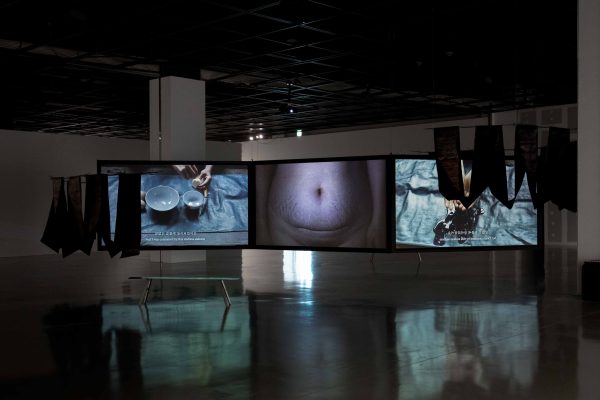
As a woman who has been caught up in my love for traditional cultures, I felt free for the first time when I realised that the door of tradition can be opened this way. Night Sutra became the ground of experimentation, which cracks open the seemingly unmovable foundation of tradition(s). When I incorporated the chapter of the Fire Trial of Sita from the Ramayana, I not only selected an Indian painting depicting the scene, I also paired it with the 16th century Bengali female poet Chandravati’s texts, which centralize the suffering of women and Sita in the story, followed by the performance of Reamker, the Cambodian classical dance rendition of Ramayana. I wanted to make manifest how a single storyline can be developed into so many regional diversities and ideological interpretations, as well as multimedia manifestations. Literature must be seen as an open space, a Barthesian writerly text that inspires individuated incantation, rather than identitarian ownership.
Such a multiplicity is a feminist strategy of undoing and redoing the weave of dominant powers. I replace the nocturnal enlightenment of the Buddha with my own awakening as a woman and a mother, the darkness of feminine sexuality misunderstood by Freud with the procreative darkness of the Dong textile, the video screen with the ornamented page, the phallus with the womb and vulva, the Indian Ramayana with the Cambodian Reamker, men’s voices with women’s expressions and presence. The undoing is a form of deconstruction to uncover the system of thinking or being thought, while the redoing is the reconfiguration of such a system by way of modification, inclusion and expansion. This is my chosen way of finding and restoring women’s voices and images that existed but were erased— to situate us in the complex weave of ethnic, linguistic, geographic, religious sectarian multiplicities and our entanglements within, rather than a simple gender identity devoid of contexts.
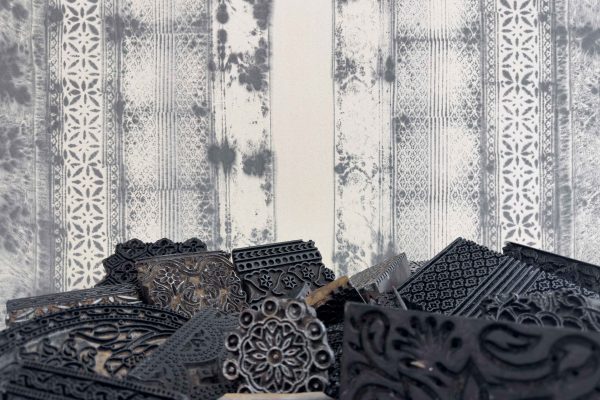
MAI: During my studio visit, we spoke about your fascination with woodblock printing practices and traditions in many locations and cultures. You told me intriguing stories about your experiences of collecting the blocks and observing them being used by craftspeople across East and South Asia. Your anecdotes about your own experimenting with making image patterns with the blocks gave me an insight into the bodily exertion demanded by this form of image making. You seem to be interested in a particular kind of relationship between the heaviness and the physical demandingness of the blocks and the almost convulsive quality of the human body in moments of making visual patterns with them. Listening to you speak of this, I think of a relationship to tradition that nonetheless involves continual adjustment, modification and reinvention.
HMY: You are right. At first, I was fascinated by woodblock printing’s transcultural history, which enabled me to reflect on my relationship as a Chinese with the rest of the world. I have come to embrace the body as an indispensable thinking organ after experimenting with the woodblocks that I collected across Asia for many years. To use the same tools means to feel how others feel and think as a body when using the same tool and working with the same materials and seeing the same motifs, and to see how others used to and now see the world. This is a form of bodily translation at play, crucial to my understanding of the tradition as a living practice.
The manual beauty of the block prints holding traces of humanity is what sustains not only the market for its products but also the tradition that allows for cultural identification. But my own use of the woodblocks in my painting made me realise how physically demanding the process is. My shoulder injury led me to my recent work, The Unbearable Purity: Three Stories, commissioned by CHAT HK. The video installation looks at the fetishisation of craft from the perspective of bodily exploitation. I question why we, like William Morris, value the manually produced textiles more than the industrial products? Must the body pay a price for the aura that should have been lost in the era of mechanical and digital reproduction? Does the Dong textile still hold Dong beliefs and ethnic authenticity when the Dong people start using machines in order to find cheaper alternatives and bodily relaxation? In order to give it a gendered dimension, I intersect these interrogations with the question of motherhood: What makes a good mother? The one who commits herself to perpetual labour to prove her purity and love?
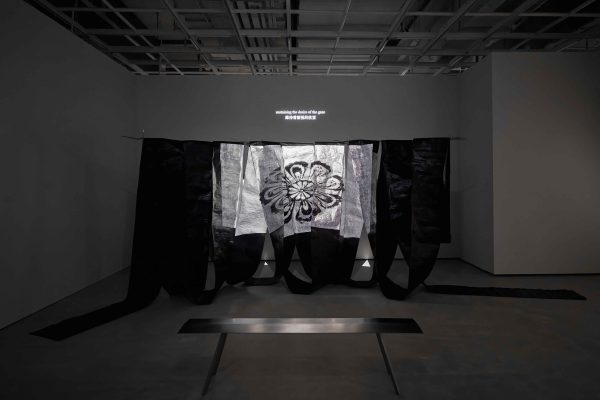
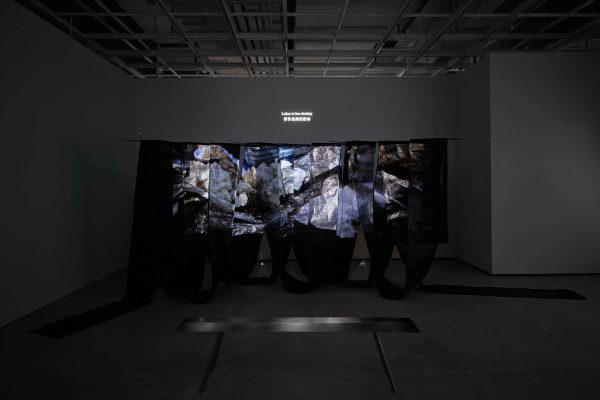
Although the work critically assaults the exploitation of the body in domestic and craft-making spheres, I am not proposing a complete mechanisation of our creative and emotional process.
Such a fetish is rooted in what we truly experience as love, in the history of making the same pattern as our ancestors, of the biological desire to care for the young and weak, of the doing and feeling that allow us to connect to the past and others. There is no easy answer for the body to choose between (self-)exploitation and genuine love, even if it were a construct. This is where logic falls short, and the body trembling with emotions starts to speak.
The third story offers a potential solution: five years ago, when I visited Jaipur, India to research the woodblock printing textile workshops, I discovered a workshop that does not use woodblock but large silkscreens that have the image of the block prints. While the speed of production greatly accelerated using this method, the craftspeople also managed to maintain a manual quality of the tradition, gone half-industrial and half manual. It is this conscious step backwards from complete industrialisation that enlightened me. The relationship to tradition is an open one and reinvention is necessary, especially when the condition of our environment has dramatically changed. To remain the same is inauthentic.
Both the bodily experience with woodblocks and the sub-stories of craftspeople’s creative subversion inspired me to develop an index of digitised images of my woodblock collection. I have employed them in both my paintings and video works, such as making stencils with enlarged motifs or integrating them into my videos to create a Buddhist manuscript, fully exploring how a block print can find a new life in different mediums, contexts and bodily engagement. Maintaining a relationship to tradition through continual adjustment is a form of co-dependence. To remove the body from the process could potentially erase our memory as a collective humanity and our interconnected histories.
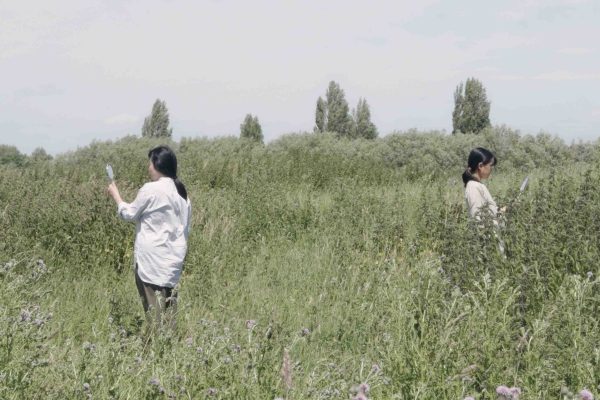
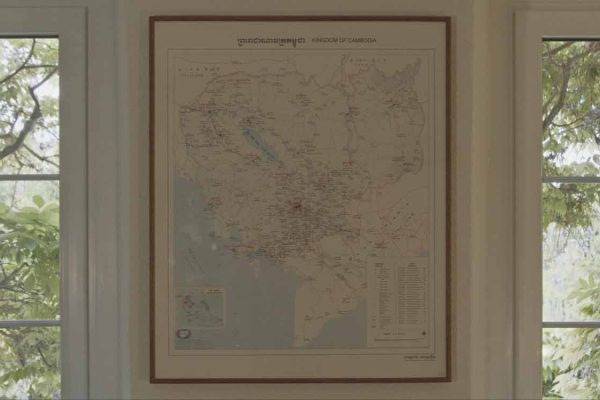
MAI: Alongside your own presence, two women figure prominently in Night Sutra. I feel that this work records an immense act of generosity. Ravann recalls her unimaginable experience of loss, suffering and survival under the Khmer Rouge regime. Sophiline, a traditional Khmer dance master, alternates between demonstrating the basic gestures of robam boran with tales of the long history of this form of dance, and her interpretation of its spiritual significance both in relation to Khmer civilisation life and in the context of Cambodia’s early modern history. I was struck by your fascination with the traditional Khmer dance and the juxtaposition that you make with the images of the troupe of female dancers and the gestures of the dance. To my untrained eyes, the robam boran, with its glacial pace, its elegant curving of the arms and hands, and its precise formation of groups of bodies, speaks of exquisite, extreme control. Yet here, in this installation, you associate your fascination with this dance form with the sexism of the Buddhist enlightenment tale. And you bring the artistry of the female dancers of the robam boran into orbit with the wildness of feminine desire. Interwoven with Ravann’s and Sophiline’s testimonies and tales is a voice-over interaction reminiscent of a psychoanalytic session. Here, your voice speaks of desire, shame and anger, of the glimpses of some kind of self beyond the prisonhouse of legible images of the woman that only flash up in the formlessness and intensity of uncontrolled rage.
HMY: My Night Practice started from such a rage, a practice of maintaining anger as a woman. Although the metaphor of the Night began as an inspirational catalyst for my poems and personal liberation during my postpartum depression, it reemerged from my feelings of deep compassion for the subaltern women. What propelled the night to include other women was the infamous Xuzhou chained woman incident that uncovered the pervasive women-trafficking across present day China starting from a town called Feng Xian in Xuzhou, where a mentally fraught woman with her neck chained and teeth pulled out were found in a hut annexed to the house in which her self-proclaimed “husband” and 8 sons live. This incident brought about nationwide outrage. For me, it was a reminder of women’s collective and connected suffering. The hollowness of her gum and her wrought womb bruised me deeply, hence my awakening: Self-preservation is not enough. Women must tell each other’s stories. Night Sutra had to be born.
To include the stories of Ravann was a natural decision because she’s the mother of my partner. To be able to record her story is a great privilege that I must handle carefully and respectfully. But it is not only this personal relationship that drove me to document her oral testimonies. The atrocities of the Khmer Rouge genocide serve as a mirror to the Chinese Cultural Revolution that underlies my intergenerational trauma. The two histories are deeply and unfortunately connected. To tell her stories is also to tell mine. And vice versa.
On the other hand, the classical Khmer dancer Sophiline sheds light on my conundrum as a female artist caught up in the double bind between tradition and modernity. Through her, I also learned about how the Khmer female dancers in the ancient past were rejected by the Buddhist temples for their great beauty and talent. My psychoanalysis recordings is the weft that connects all the threads – Ravann, Sophiline, ancient Khmer dancers, as well as Sita in Ramayana, the Buddha’s mother Mahaprajapati, the prostitute Kamala in Hermann Hesse’s Siddartha. I utter rage and the absence of self-image, as I have personally intersected all these identities—as a Chinese related to the modern Cambodian history, a female artist, a lover and a prisoner of Buddhism, a wife, a mother, and a woman with sexual desires. Through weaving these narratives so tightly and in constant alternation, I wish to create a web of interconnection across time, geographies and (literary and imaginary) realities in order to ask the question: How can a female artist find her way out of this tunnel of darkness flanked by historical injustice and massive destruction? The formlessness of being a woman is the darkness that I refer to in my psychoanalysis, the darkness that enraged me and the darkness that I must not look away from but transform into the Night that emancipates.
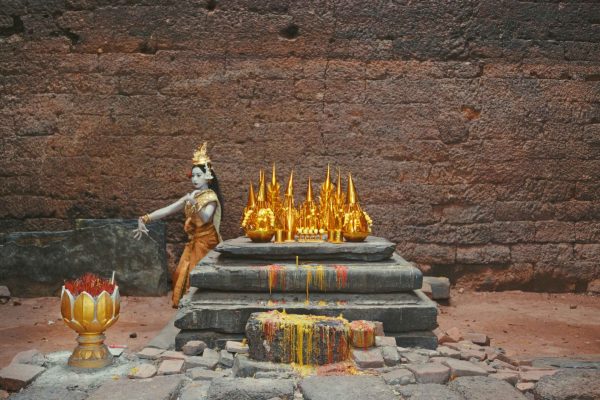
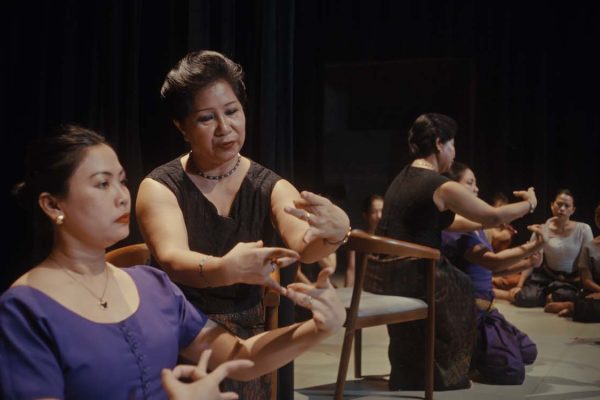
MAI: The multiplicity of languages, letters and texts in your installation brings me to the motif of the open-book. Here, I wonder about the connection between your epistemological, art historical and artistic interests in civilisational scales of time and in creatively engaging with tradition.
HMY: Multiplicity is central to my epistemological approach that underpins the art historical and intellectual engagements in my practice. I believe wherever multiplicity exists, relationships emerge. My longue durée approach to Chinese art history reveals that the formation of Chinese culture is deeply interconnected with other cultures through historical hybridisation and intercultural exchange across Eurasia. This multiplicity of influences and conversation shapes the profoundly intercultural nature of human history. The open-book motif in my painting and video practices is a crucial device in making such interconnections manifest, originating from my search for an alternative paradigm for image-making that diverges from Eurocentric frameworks, particularly the dominant “oil-on-canvas” tradition of modernism. My studies in Sanskrit, Persian, and Arabic, as well as Indian and Islamic art and intellectual histories, have informed this new paradigm that takes inspiration from a wide range of book art, from Indian and Persian miniature paintings in manuscripts to Chinese and Japanese block prints. I conceive of books as open spaces connecting diverse cultural traditions while preserving their unique epistemological identities as the configuration of the page and binding methods reflect culturally, historically and linguistically specific modes of thinking. But my interest in multiplicity also has a subversive undertone. I consider my passion and desire for traditional cultures a polyamorous one, but I have no desire to be part of any lineage. To put it in simple words, I don’t want to be the wife or daughter of traditions, but I wish to remain as a “lover” of tradition outside of the domain of a committed marriage or even ethics. That decision comes out of the tension between my genuine appreciation and the sober realisation of the impossibility of belonging to a tradition that has historically excluded women like me, and to the traditions that I have never been part of with my given identity. But I still choose to love and engage in a way that frees me, that allows me to flirt with the many Fathers, enjoy and betray as I wish. Instead of abandoning traditions altogether, which might lead to atrocities like the Khmer Rouge genocide, I wish to remain a complicated relationship with the many so as to reconfigure and transform them. Or at least devour them as part of me. The body is also a book.
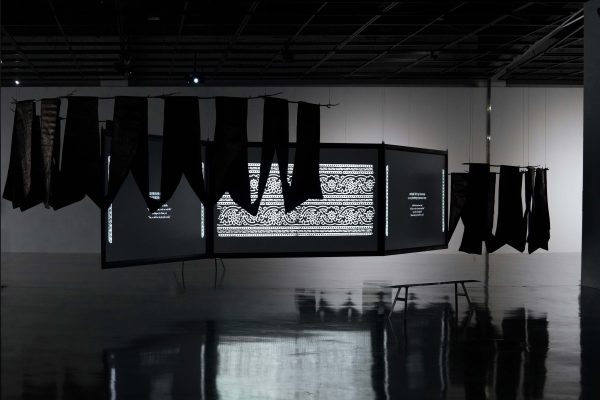
MAI: Lastly, as an artist engaging with questions of motherhood, femininity, cultural identity and tradition in contexts of global contemporary art, I wonder if you would be tempted to share any thoughts or experiences of navigating or countering expectations in this context of practice.
HMY: I’ve often encountered situations where my motives, subjectivity, and agency were challenged and scrutinised. Accusations such as “A Chinese should not be interested in India and Islam” or “It’s not acceptable that you are trying to represent Indian and Arab people” were often pointed at me before I could provide context or explain my intentions. At first, I could only react with anger. Over time, however, I’ve learned to respond differently, sharing stories that invite others into my complex world of experiences, emotions, and perspectives, while simultaneously exploring the historical and political roots of such biases.
I carry several persistent questions with me: What compels people to prevent others from embracing cultures different from their own? How can I demonstrate the authenticity of my interest—or must I even attempt to? Why have many forgotten or ignored the historical exchanges between China, India, and other regions? As a Chinese woman and artist, what actions or interests are considered permissible, and which are not? Are ethical boundaries context-dependent or universally applicable? What constitutes ethical cultural engagement versus harmful cultural appropriation? Is it justifiable to judge a Chinese female artist by the same standards applied to a white male artist, considering the vastly different historical relationships of oppression and power dynamics? Could categorising aesthetic and artistic agency itself be a form of (self-)Orientalism? Why is my interest in non-Western cultures questioned, yet my deep immersion in Western culture normalised? What can we learn by examining these double—or even triple—standards? What is the extent of freedom for artists working within the global contemporary art scene shaped by post-colonial contexts? Finally, how can we foster open, productive conversations about these complex issues to move beyond restrictive notions of cultural ownership while remaining sensitive to histories of oppression and inequality? Perhaps these questions cannot be answered easily or immediately, but I encourage reflection and dialogue.
For an individual woman trying to carve out her own way, remain porous, transgressive, mobile and creative, it inevitably involves risks and misunderstanding. But I often remind myself that I have experienced death and extreme physical trauma when giving birth and nothing can be tougher than that. Death gave me the freedom to live fully. I do not try to simply counter expectations because it might result in the mere product of reaction, which can obscure our true desires and visions. What I hope to share is something that both my mother and the Buddha said: “Have no fear.” I let this fearlessness guide me.
